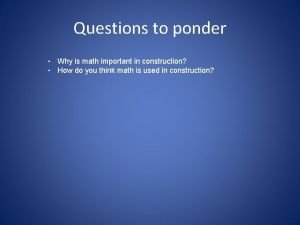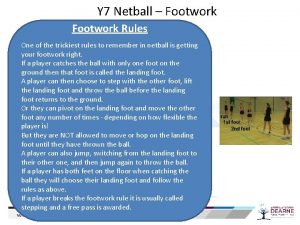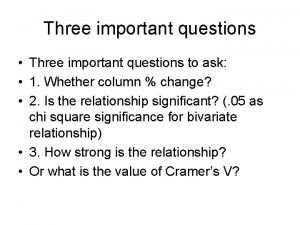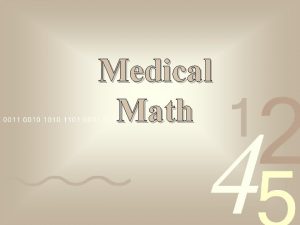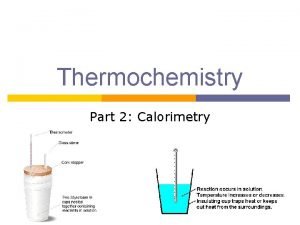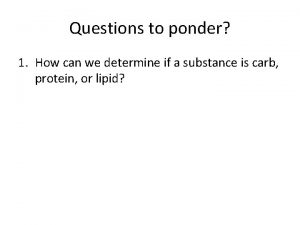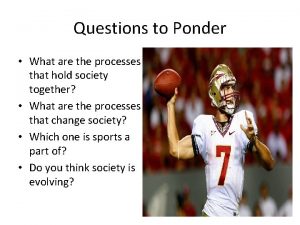Questions to ponder Why is math important in











































- Slides: 43

Questions to ponder • Why is math important in construction? • How do you think math is used in construction?

Intro to Construction Math

Whole Numbers Whole numbers are complete units without fractions or decimals.

Parts of a Whole Number units tens hundreds thousands ten thousands hundred thousands millions 5, 3 1 6, 2 4 7 This number has seven digits. Digit – any of the numeric symbols from 0 -9.

4, 467, 903 What number is in the thousands place? 7 What number is in the tens place? 0 What number is in the hundred thousands place? 4

Adding Whole Numbers When you add 2 or more numbers the total is called the sum. If you add 58+34: 58 + 34 Is the answer 8 12 ? ? ? 8+1=9 ……. thus the sum of 58+34 is 92 No, you have to carry the tens part of the sum from the units column to the tens column and add it there.

Subtracting Whole Numbers Subtracting one number from another is finding the difference. 13 – 6 = 7 Thus the difference between 13 and 6 is 7

Multiplying Simple Whole Numbers The most efficient way to add the same number together many times is multiplication. 3 + 3 + 3 + 3 = 18 OR 3 X 6 = 18

Dividing Whole Numbers When dividing, the number you are dividing by is called the divisor. 14 2 divisor

Jobsite Applications If you have 364 boxes of drywall screws that must be divided equally between 7 job sites, how many boxes does each site get? 364 7 52 boxes Job sites Boxes/site

Jobsite Applications You have a piece of pipe that is 150 feet long. If you cut the pipe into 10 pieces of equal length, how long will each piece of pipe be? 150 = 10 15 feet per piece

Using a Calculator The calculator is a very efficient tool for saving time. Basic functions: - Add - Subtract - Multiply - Divide - ON/C turns on and clears the calculator

Applications 1. You have a piece of wood 86 inches long. If you cut off one foot. How long will the piece of wood be? 2. Yesterday, a supply yard contained 93 tons of sand. Since then, 27 tons were removed. How many tons of sand is left in the supply yard? 3. A roof contains 11 trusses. A company is building 8 roofs. The company will need to order how many trusses? 4. A worker has been asked to deliver 15 scaffolds to each of 26 sites. How many scaffolds will the worker deliver? 5. If cast iron pipe weighs 8 pounds per foot, 65 feet weighs? 6. You need to lay a line of bricks that is 96 inches long. Each brick is 4 inches long. How many bricks will you need to build the wall?

Intro to Construction Math

Working with Measurements • Standard ruler/measuring tape – you MUST learn to recognize the distances shown on the standard ruler/measuring tape. - a yardstick is a standard ruler that is 3 feet long • Architect’s rule – scaled measurements: - ¼” = 1’ - 3/8” = 1’

Fractions Divides a unit into parts: numerator 1 4 denominator

Fractions on a Ruler A B C What is A pointing to? ½” What is B pointing to? 1 ½” What is C pointing to? 2 5/8”

Finding Equivalent Fractions ¼” = ___/16” 4/16” 2/16” = ___/8” 1/8” ¾” = ___/8” 6/8” 10/16” = ___/8” 5/8”

Finding Lowest Common Denominator 1. Reduce each fraction to its lowest terms 2. Find lowest common multiple of the denominators 3. If neither of the denominators is a multiple of the other, you can multiply the denominators together.

Find Lowest Common Denominator for the Following Fractions 2/6 and ¾ = _______ 12 ¼ and 3/8 = _______ 8 1/8 and ½ = _______ 8 4/32 and 5/8 = _____ 8

Adding Fractions ¼ + 3/8 = ______ 5/8 3/16 + ¼ = _____ 7/16 5/8 + ¼ = ______ 7/8

Subtracting Fractions Reduce your answer to lowest terms 7/8 – 3/8 = ______ 1/2 ½ - ¼ = ______ 1/4 7/8 – 3/9 = _______ 7/24

Multiplying Fractions 1. Multiply numerators together. 2. Multiply denominators together. 3. Reduce if possible. ¼X¼= 1 X 1 4 X 4 Thus you get 1 over 16 or 1/16

Dividing Fractions Using: ½ / ¼ as an example, follow these steps: 1. Invert the fraction you are dividing by (1/4). ¼ becomes 4/1 2. Change the division sign (/) to multiplication (X). ½ / ¼ ……now becomes ½ X 4/1 3. Multiply the fractions. 4. Reduce if possible. 1 X 4=4 2 X 1=2 4/2 reduces to 2

Decimals Machinist’s rules uses decimals instead of fractions. Thus a screw measuring 3 7/10 long is written as 3. 70 inches

Decimals Put the following decimals in order from smallest to largest: . 012, . 210, . 112, . 201. 012. 112. 201. 210

Conversion Processes Decimals, fractions and percentages are just different ways of expressing the same thing. 4. 25 = 4 ¼ 4. 25% =. 0425

Converting Percents to Decimals Convert 47% into decimal form. 1. Drop the percent sign 47 2. Move the decimal point two places to the left 47. Thus 47% in decimal form is. 47

Metric System Units of measure: - Grams = weight - Liters = volume - Celsius = temperature - Meters = length

Metric Prefixes The most common prefixes are: • Kilo • Milli • Centi *Blueprint measurements most often are given in centimeters and millimeters.

Job Site Application You need to mix 42 pounds of mortar. Each pound of mortar mix requires 0. 03 liters of water. How many liters of water do you need? (round to nearest tenth). 42 x. 03 1. 26 pounds of mortar liters per pound liters of water 1. 3 liters of water

Construction Geometry Everything in construction is made up of different shapes: - Circles - Triangles - Squares - Rectangles

Angles are important in construction. You use a tool called a protractor to measure the degrees of an angle

Shapes Rectangle – four sided shape with for 90 -degree angles. (The sum of all four angles of a rectangle is 360 degrees)

Shapes Square – special type of rectangle with four equal sides and for 90 -degree angles.

Shapes Triangle – closed shape that has 3 sides and 3 angles. (The angles of a triangle can vary but their sum is always 180 degrees).

Shapes Circle – closed curve around a center point (circles measure 360 degrees)

Area of Shapes Area is the measurement of the surface of an object. 2 Square Inch = 1 inch X 1 inch = inch 2 Square foot = 1 foot X 1 foot = foot Square yard = 1 yard X 1 yard = yard 2

Calculating Areas of Shapes • • Rectangle – length X width ( L x W) Square – length X width (L x W) Circle – pi X radius 2 (3. 14 x r 2) Triangle – ½ X base X height (½ b x h)

Job Site Applications 1. You have to lay a floor for a 14 x 14 shed. The area of the floor is how many square feet? 2. You want to paint the walls of a 10 x 10 room. If the walls are 8 feet high, how many square feet will you be painting? 3. You want to lay marble in a 11’ x 15’ foyer. If the boxes of marble contain 11’ 2 , how many boxes will you need?

Volume of Shapes Volume is the amount of space occupied in three dimensions. 3 Cubic inch = 1 inch X 1 inch = inch 3 Cubic feet = 1 foot X 1 foot = foot 3 Cubic yard = 1 yard X 1 yard = yard

Calculating Volume of Shapes • Rectangle – length X width X height (Lx. Wx. H) • Square – length X width X height (Lx. Wx. H) • Cylinder – pi X radius 2 X height (pi x r 2 x H)

Job Site Applications 1. You are going to pour a concrete driveway that is 16’ by 22’. The thickness of the driveway will be 6”. What is the overall amount (volume) of concrete need in cubic feet? 2. Using the above example. If concrete is sold by the cubic yard, how many cubic yards would you need to order?
 A thought to ponder math
A thought to ponder math Pictures
Pictures Math in culinary arts
Math in culinary arts Stephen ponder md
Stephen ponder md Quote to ponder
Quote to ponder Ponder in research
Ponder in research Some thoughts to ponder
Some thoughts to ponder Point to ponder example
Point to ponder example Statements to ponder
Statements to ponder Jaroslaw ponder
Jaroslaw ponder Dont ask
Dont ask From most important to least important in writing
From most important to least important in writing From most important to least important in writing
From most important to least important in writing Least important to most important
Least important to most important Topmarks
Topmarks Crucifixion quotes gcse
Crucifixion quotes gcse Netball footwork rules
Netball footwork rules Items that distort or prevent communication
Items that distort or prevent communication Why experience is important
Why experience is important Planning strategies
Planning strategies Why is water important to living things
Why is water important to living things Why reading is so important
Why reading is so important Why is physical diversity important
Why is physical diversity important Why careful selection is important
Why careful selection is important Why are rivers important
Why are rivers important Dumbking plant
Dumbking plant What is selfawareness
What is selfawareness What is passober
What is passober What is advent
What is advent What to do during ramadan
What to do during ramadan Why are wetlands important
Why are wetlands important Zero based forecasting in hrm
Zero based forecasting in hrm Uml 0..*
Uml 0..* L
L Why is time management important
Why is time management important Why is food quality important
Why is food quality important Why is culture important
Why is culture important Importance of compliments
Importance of compliments Health triangle questions
Health triangle questions Why is genetic diversity important
Why is genetic diversity important Why is the sun important
Why is the sun important Why is keyboarding important
Why is keyboarding important Human taxonomy
Human taxonomy Important of symbols
Important of symbols
